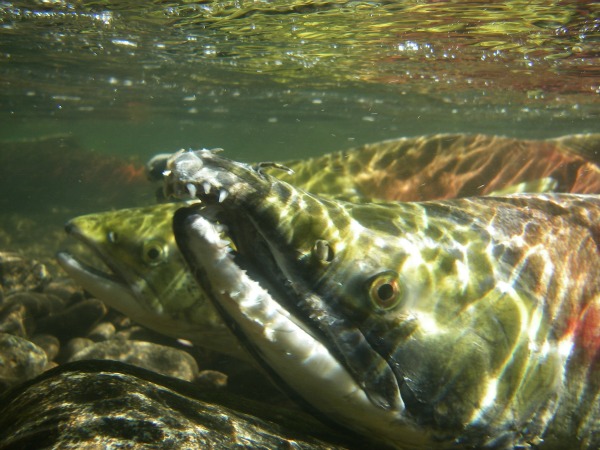Salmon Swim Home Using Earth’s Magnetic Field as a GPS
Their intuitive sense of the magnetic field surrounding them allow sockeye salmon to circumnavigate obstacles to find their birth stream

Sockeye salmon rely on a magnetic map to navigate home after years spent at sea. Credit: Putman et al., Current Biology
Scientists have long known that various marine animals use the earth’s magnetic forces to navigate waters during their life cycles. Such inherent navigational skills allow animals return to the same geographic area where they were born, with some migrating thousands of miles, to produce the next generation of their species.
As hatchlings, sea turtles scuttle from their sandy birthplace to the open sea as if following an invisible map, and, as adults, the females return to that spot to lay their own eggs. Bluefin tuna home in on their natal beaches after years at sea to spawn. Similarly, mature sockeye salmon leave open water after gorging on zooplankton and krill to swim back to the freshwater streams and rivers in which they were born.
But the mechanisms underlying this behavior are not well understood for most species, including the silver-bellied salmon. Previous studies suggest that tiny variations in earth’s magnetic field might have something to do with it, but research has been mostly limited to laboratory experiments—until now.
Using fisheries data spanning 56 years, researchers examined sockeye salmon’s mysterious sense of direction in their natural habitat. The findings, reported online today in Current Biology, show that sockeye salmon “remember” magnetic values of geographic locations. They imprint their birth location on this map when they leave their freshwater home for the sea, and use it as a compass during their journey back several years later, successfully returning home to spawn.
The salmon in this study originate in British Columbia’s Fraser River. They typically spend two to four years at sea, distributed widely throughout the Gulf of Alaska. As ruby-colored adult salmon, they begin their trek home. But on their way, they encounter a roadblock: Vancouver Island, the top of a submerged mountain range that stretches for 285 miles from the Juan de Fuca Strait in the south to Queen Charlotte Straight in the north. To get back to the Fraser River, the fish have to choose—the northern inlet or the southern inlet?
If the fish did possess some internal GPS that uses earth’s magnetic field as a map, researchers expected to see the salmon’s choice of inlet change in predictable ways over the years. This is because the planet’s magnetic field doesn’t remain constant; the field’s intensity and small-scale patterns change gradually over time through a process called geomagnetic field drift, caused mainly by movement in the Earth’s fluid core.
And that’s exactly what researchers observed: salmon showed a greater preference in a given year for the inlet that most closely resembled the magnetic signature of the Fraser River when they swam from it two years earlier. Their homeward route reflected how closely the field at each entryway, at the time of their return, resembled the field that the salmon experienced two years before, when they left the river to forage at sea.

Sockeye Salmon from Fraser River in British Columbia typically spend two to four years at sea, feeding on zooplankton. Credit: Current Biology, Putman et al.
Specifically, as the difference in the magnetic field’s strength between the Fraser River and Queen Charlotte Strait decreased, a higher proportion of salmon migrated through the northern inlet. Likewise, when the difference in magnetic intensity between the river and the Strait of Juan de Fuca decreased, a higher proportion of salmon migrated through the southern inlet.
For salmon, this ability is important, and in some cases, a matter of life and death. Efficiently navigating from foraging grounds to coastal breeding areas means more time spent feeding in open water, which translates into more energy for the journey home, researchers say. The imprinting capacity also ensures salmon reach their spawning sites at the right time.
Understanding this capacity may have implications for both wild and farmed salmon, a commercially important fish. For the last decade, salmon has been the third most consumed type of seafood in the United States, behind canned tuna and shrimp, with the average American citizen chowing down on two pounds of the fish per year.
“The Earth’s magnetic field is quite weak compared to the magnetic fields that humans can produce,” said study author Nathan Putman, a professor in the fisheries and wildlife department at Oregon State University, in a statement. “If, for instance, hatchery fish are incubated in conditions with lots of electrical wires and iron pipes around that distort the magnetic field, then it is conceivable that they might be worse at navigating than their wild counterparts.”
/https://tf-cmsv2-smithsonianmag-media.s3.amazonaws.com/accounts/headshot/marina-koren-240.jpg)
/https://tf-cmsv2-smithsonianmag-media.s3.amazonaws.com/accounts/headshot/marina-koren-240.jpg)